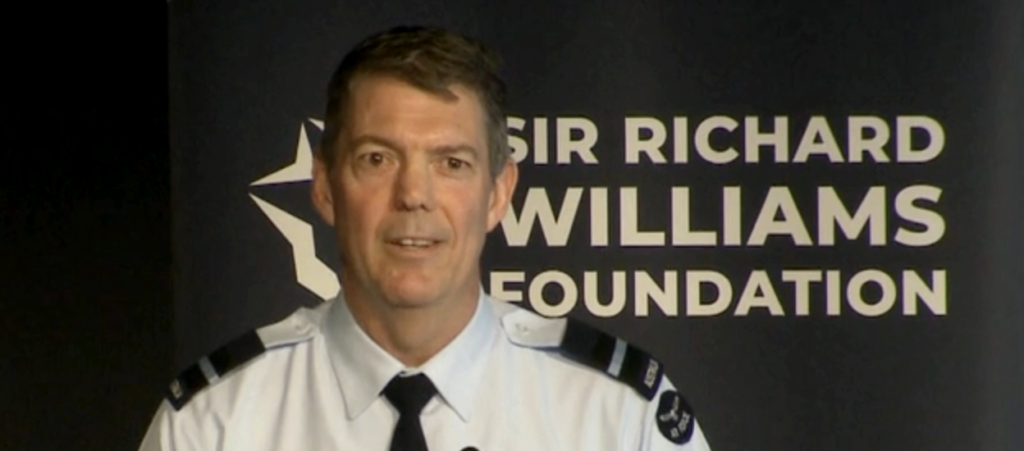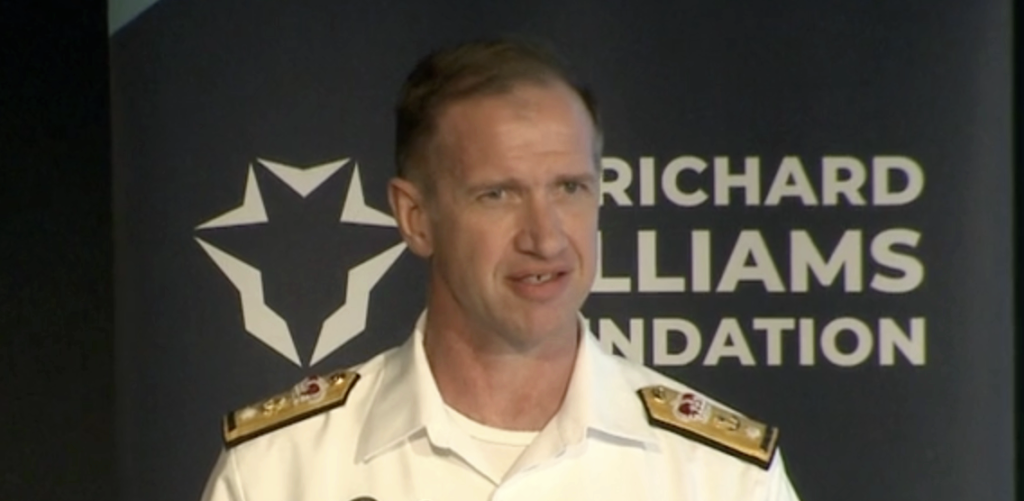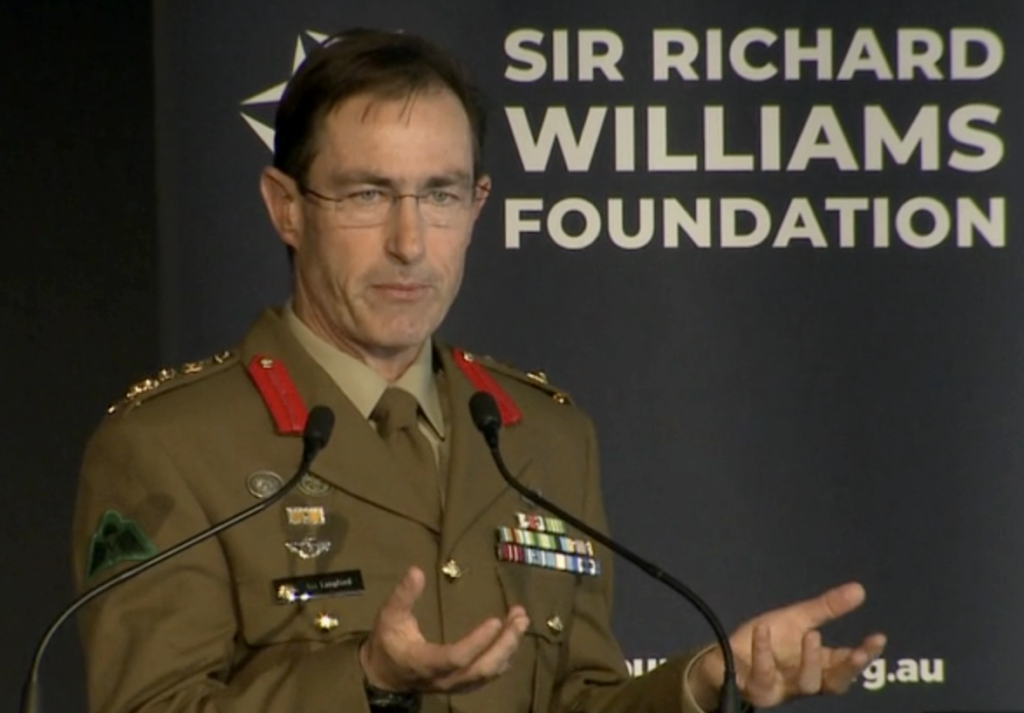The ADF and the Australian Space Enterprise
At the December 1, 2021, Williams Foundation seminar on shaping a way ahead for the Australian space enterprise, a key theme was how the Australian Defence Force (ADF) works with that enterprise and shapes a way ahead for military space.
AIRCDRE Nick Hogan, Director General Space Domain Review, provided on overview on the emerging approach to how the RAAF and Defence are addressing military space.
In an interview which he provided to the Williams Foundation separate from the presentation at the seminar itself, he highlighted the way ahead.
“The space organization that we’re starting up in January 2022 is a whole of defense organization. While Air Force will host space, it certainly does not own it. Space is a multi-domain capability, so certainly not owned by anybody in particular…
“The space organization we are setting up will be a flat structure by necessity. And when I say by necessity, we will have a two-star lead with three, one star or band one equivalents that sit underneath her and then underneath that it’s a pretty skeleton like structure.
“We will also bring in other organizations like the Australian Space Operation Center inside the organization…We are literally quite lean by design so that not only do we have a requirement to keep it lean so that we don’t have as much of a resource burden across the services because of course we’re doing this within our resources right now, as well as doing everything else that we normally do.
“But also, we want to be able to get the lower ranks engaged who have more experience in space. We’re in an unusual situation here where we are standing up an organization where the person who leads it isn’t the most experienced person in the organization. We are standing up an organization where the lead of the organization doesn’t know as much about space as some of the junior people who have been in it for a long time. Having those junior people come into the headquarters provides us with that experience. It’s a great opportunity to be a lean and agile organization and I think that’s what you’ll see at the organization next year.”

He noted that on October 12, 2021, the defense space enterprise concept was presented to the Chiefs of Service Committee. That document focused on the roles, responsibilities, and authorities for the Defense Space Commander.
As the ADF shapes and interacts with the evolving Australian space enterprise, they are doing so in the context of a broader set of space developments affecting their partners and allies as well. This means that they can take account of broader allied efforts as they shape their own as well.
He highlighted that a key focus of their space effort was upon supporting the joint warfighter. This is also part of shaping a broader national security strategy for whole of government. “We need to understand the effects of space on our security.”
The workforce needs to have the flexibility to get full value from the evolving space work force, inside and outside of government. “What does that mean in the defense context? It means allowing people to go into industry, come out of industry, work back inside the fence. That will allow us better understanding as we move forward, truly moving forward.”
He underscored the need for new training regimes, including the formation of a space warfighter course. And it is important to ensure that such a perspective fits into the evolving integrated force approach or concept.
Such a focus would lead to a conclusion suggested by David Ball, regional director, Australia/New Zealand for Lockheed Martin Space. The investments being made in satellite communications need to ensure that real world warfighting needs are met.
“We need to make sure that it’s military-grade and it does provide the resilience that we need to have in such an important system. We see increasing counterspace activities by adversaries in this region, we’ve seen anti-satellite attacks recently, we’ve seen co-orbital attacks from another spacecraft. Those technologies are advancing rapidly, and we need to be very cognizant of those changes as we build up our network. It’s something the satellite industry needs to take care of in all facets in the space segment as well as the ground segment and the control segment.”

And in Ball’s assessment this means that space although a distinctive domain is embedded in a wider information warfighting environment facing the ADF. “In addition to the physical risk I just talked about, there’s always a cyber risk, and we’ve seen government recently make announcements in this regard about critical infrastructure in this country. That applies to civilian networks as well as to military networks, so industry as a whole needs to respond and be aware of these as cyber risks and make sure that we have bulletproofed our systems to ensure that people can’t get in to attack.”
When one focuses on defence, it is always crucial to remember that it is an entity which is engaged in the ongoing defence of the nation. And as the major authoritarian powers are engaged in my view in ongoing limited war with the liberal democracies to seek to gain escalation control dominance, the focus is upon the future is now. It is important to have long-term objectives, but one must just think back to 2019 to look at how good the forecasts were for the world in 2020 to understand the need for modesty when making long-term projections.
The presentation by the commander of the Air Warfare Centre, AIRCDRE Ross Bender provided an assessment of the way forward grounded in this reality.
“If we need to go and conduct an operation in the next 12 months to two years, what do we know of the environment?
“What do we know of the options we have available?
“What are our vulnerabilities?
“What are our key support requirements from our coalition partners to enable us to provide options to the joint force?
“That’s the focus that I have in my current role. We need to work with industry, academia, and the coalition partners to identify those options and then explore them, so that day zero, I can be prepared to fight. Rather than day one, trying to make it up on the fly while we understand what we can and can’t do.”
AIRCDRE Bender underscored a core point for today’s operating force which is crucial to focus upon and to work solutions.
“Space domain awareness is critical for today’s fighting force. The reason can be reduced to one word and that is dependency. Dependency in joint operations translates to military vulnerability, which in turn may identify opportunities for an adversary.

“Australian defense-based capabilities and operations are significantly dependent on the U.S. for access to space-based capabilities, along with the provision of accurate and validated observations of objects in space….
“The U.S. operates and maintains a space surveillance network that consistently collects observations on all observable space objects from multiple sensors, spreading around the globe, to extrapolate and validate orbital elements, which then form a space object catalog. The U.S. space catalog is maintained at different classification levels, and one of the primary contributors to developing space domain awareness.
“Therefore, continued access to these catalogs is a critical vulnerability that the government plans to mitigate through the development of a sovereign space domain awareness capability.
“It is important to note that with the focus on developing sovereign defense space capability, it might be perceived that defense may be disconnecting somewhat from our allies and partners. This could not be further from the truth. Australia holds a unique geographical position to contribute significantly to collective space domain awareness with our allies and partners, as evidenced by Defence currently hosting a U.S. ground space-based surveillance sensor.
“Defence space capability delivers desired effects in supportive joint operations through the use of space as an operational domain. The desired effects are provided through space battle management, missile warning operations, access to and management of space services, including SATCOM and GPS, and access to space-based intelligence, surveillance, and reconnaissance systems. And underpinning all of this is developing and maintaining consistent and comprehensive space domain awareness.”
When considering a realistic and effective way ahead for the ADF in space, Malcolm Davis sensibly focused on how Australia can work the high-low mix or focus really on the new space approach to satellite build and launch, and craft capabilities to work, in effect, ISR constellations. He argued at the seminar that by using small satellite systems Australia could shape sovereign space-based targeting for strike capabilities. Combined with innovations in reusable launch, small sats can provide the ADF with significant new capabilities.
Such capabilities are part of the kind of resilience which the ADF is broadly seeking. As Davis put it: “Why should we do this? Why should we invest in sovereign capabilities? It’s all about resilience. It’s all about having the ability to maintain operations and maintain capability in a contested environment. We are responsible for this, not the Americans, not anyone else, it’s down to us to deliver this capability.
“At the same time as we develop these resilience capabilities, we need to expand our ability to contribute towards deterrence, because that gives towards the common good of preventing a Pearl Harbor in space.”
A Navy perspective on space was provided by CDRE Matthew Doornbos, RAN Director General Navy Intelligence and Information Warfare. He argued that “The ability to access services and benefit from space related war fighting effects and synchronizing and coordinate them with other kinetic, non-kinetic effects and physical maneuver is critical to vitality and survivability of a deployed maritime task group. Controlling the seas and projecting power from the sea complicates the strategic situation for adversaries and competitors.
“As Director General Navy Intelligence and Information Warfare, I have responsibility for the oversight over the Maritime Commander Control Communications, Computers, Cyber, Intelligence, Surveillance, Electronic warfare program, or more simply the MC5ISR program, which include Navy’s endeavors in the space domain.
“The creation of the program was approved by government late last year and brings together all of Navy information warfare projects under one overarching program. It includes several projects that are already delivering and several projects which deliver over the next 20 to 30 years.

“A notable endorsement by government of the program is the adoption of a continuous capability development system that enables defense the ability to maintain tactically relevant, technically advanced, in fit for purpose systems that enable the maritime force to maneuver within the electromagnetic spectrum in a degraded, denied, intermittent or limited environment. At the same time, it allows us to the capability for degrading or denying adversaries freedom maneuver.
“The requirement for the program was driven out of a growing realization that the current rate of technology advancements, and our contrasting inability to deliver new capability at a similar rate. It was realized that our limitations for providing rapid responses to emerging threats was derived from our process of implementation and not necessarily our capacity to develop the technology.
“The future of warfare is being shaped by the world advancements in technology. And we must stay at the forefront. The rapid pace of technology development means that Navy’s mission is now only achievable through the nexus of maritime, air, land, cyber, and space domains. Navy gains several critical information advantages through space, position, navigation, and timing. B&T such as GPS provides precise geolocation, navigation, time reference services. Information essential for all Navy’s networks, sensors, weapon systems including future non-kinetic effects to be delivered through the program….
“This network provides the central warning for counter advanced ballistic missile capabilities. Intelligence surveillance reconnaissance, space based optical radar and RF sensors have been long used to support military operations. Such platforms may previously be beyond the reach of potential adversaries. Contemporary counter space authorities can’t hold these assets at risk. As soon as we leave the wharf, these space-based communications are being placed at risk in a congested and contested spectrum environment.”
Operating within the dynamic war fighting environment relies on access to space and doing so requires in his view the ability to shape, support, and leverage the wider evolving Australian space eco-system.
“We cannot rely on our major primes and institutions alone. Therefore, we must identify the importance of implementing the smaller players within the industry to contribute and develop our key resource, and that is our people. My goal is to develop and build and nurture the relationships between defense industry and academia. In doing so, I seek to build that academic base and give depth and breadth to support Navy’s, C5ISR needs. This partnership, where we’re all able to understand each other’s needs and pressures, will lead to a better outcome for all of us collectively.
He then added that: “Navy may need to leverage commercial capabilities that reduce the cost of access to space and increase the utility and the availability of space-based systems. Navy needs to establish processes for developing and managing space expertise for our sailors. In information warfare related work groups, current career streams do not provide a path to upscale individuals, who would form the core of professional workforce in our Navy to stay abreast of rapid developments in tactics, techniques, procedures, and capability. Concurrently, Navy needs to train its officers with specialist space effects and information warfare knowledge to generate, integrate and synchronize space capabilities into maritime task group operations.
He added: “In order for us to predicatively move forward with the necessary research and development and basic science and technology to meet our capability needs, there needs to be a level of funding behind the research. It’s a simple fact. That’s why we need to fully utilize the funding opportunities available to us through the defense innovation hub.
“And for instance, the DSTGs next generation tech fund, these collaborative ambitions serve to rider a solid foundational relationship and can enable defense industry and academia to establish corporate process in a practical sense.”[1]
An Army perspective on military space was provided by BRIG Ian Langford, Director General Future Land Warfare. “As part of the joint force, the Australian Army must contribute to orchestrating effects across all domains, to include space with our like-minded partners and allies. The more cohesive, integrated, and network force that we generate as part of the joint force, the more effective we will be in leveraging this domain.
“Army’s contribution to space power is obviously not new. And as the ADF recapitalizes, to include its diverse space workforce, it’ll require expertise to be drawn from across army, navy, air force, the public service, contractors, academics, and industry, if we are to realize this ambition and the responsibilities that we have towards safeguarding the nation.
“For our army, they exist inside our sixth brigade, which is that part of army which raise, trains, and sustains our air defense, our ISR electronic warfare, and our long-range fires community. That organization and those people within will need to be skilled, and in some cases re-skilled, across the decade as the ADF space strategy becomes realizable. It becomes less important of the fact that individuals join the army navy and air force rather than the fact that they’re now part of the ADF and the uniform they wear will be less important than perhaps the domain that they operate in…

“The generation of space power for army will require more than just the employment of space systems. It will demand a coherent joint and integrated culture in space domain, increasing the awareness of space power within army and across defense. We must understand how each of the constituent parts of military power are enabled by the other.
“And this prepares our people for roles across the department, outside of this service, expands our thinking, and ultimately contribute to our ability to be successful both in single, unified, and multi-domain operations. Army’s access to terrestrial and orbit satellite assets, for example, provide a spectrum of offensive and defensive capabilities to protect and defend the space domain.”
Finally, AIRCDRE Phil Gordon, Director General Air Defence and Space underscored with regard to the Australian space effort: “We are on a journey, but we’ve got a long way to go to achieve professional mastery. We need at all levels of defense, leadership, and government to be informed and understand what it means when someone cozies up to one of our satellites, starts fiddling around, well, what does that mean? What should we do about that? We need to take an integrated commander control approach.
“This is a key part of the joint force. We’re not just making space versus space decisions. Space is not just a special domain but one which impacts on all other warfighting domains.”
Certainly, as Australia looks to add long-range strike, space capabilities are a key part of such a system. And that really is the point. Shaping sovereign space capabilities is a key part of the ability of Australia to have the kind of decision making appropriate to operate in the gray zone, hybrid war or what I prefer to call it engaging effectively in the ongoing limited wars and escalation control challenges being posed by today’s authoritarian peer competitors.
As Gordon put it: “If we are going to make a decision to go to war, we probably shouldn’t just take someone else’s word for it. What happened? You could look back to the decisions around the invasion of Iraq and the fallout of that and weapons of mass destruction. Do we want to just rely on other people’s assessments of why our satellite just stopped communicating with us? Or do we want to have a way to independently collaborate and corroborate that information.”
We put it this way with regard to defense in our book on European defense: “But it is clear this is not the 19th century in that no Western state can directly defend itself and its interests by itself. We are in a situation where even powerful Western states can only pursue defense and security strategies from a position of semi-sovereignty.
“The fundamental reality is that defense is national but executed in a situation of semi-sovereignty. It is not only shaped by semi-sovereign relations with other liberal democratic states but also in terms of sorting through the kind of relationships liberal democratic states will have with 21st century authoritarians which now operate both internally and externally with regard to the liberal democracies themselves.
“Alliances are crucial but not definitive in solving the direct defense challenges facing today’s liberal democratic states. National goals and objectives need to be clearly identified, stated and pursued but done so with regard as well to ensuring ensuring that those liberal democratic states most willing to act in support of your nation’s more enlightened objectives are on the same page with regard to how best to handle full spectrum crisis management.
“Nations remain the focus for defense and security, even though what has emerged is clearly semi-sovereignty even for larger nations. Part of shaping the way ahead for a nation is to have tool sets which not only can defend its interests but also trigger collaboration with core partners to ensure that the overall result is more capability on the basis of “enlightened” nationalism to act, rather than on simply more agreement to discuss, but with little ability to be able to act during a crisis.”[2]
The featured photo shows AIRCDRE Gordon speaking at theWilliams Foundation seminar on space.
[1] https://www.dst.defence.gov.au/nextgentechfund
[2] Robbin Laird and Murielle Delaporte, The Return of Direct Defense in Europe: Meeting the Challenge of XXIst Century Authoritarian Powers (2020), chapter five.

